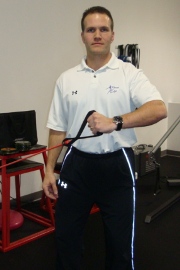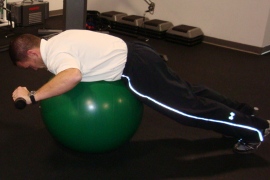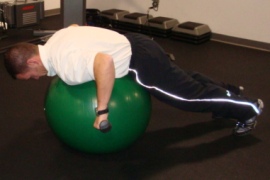There are three different ways to strengthen the posterior rotator cuff. According to EMG studies, the most effective ways to isolate maximal voluntary isometric contraction (MVC) are:
- Side-lying external rotation
- Standing external rotation in 45 degrees of abduction
- Prone external rotation in 90 degrees of abduction
Application
This exercise is relevant if you are working with clients who need posterior shoulder strengthening to optimize shoulder function and rectify muscle imbalances. Most clients will have overdeveloped deltoids and underdeveloped posterior cuff strength. Utilizing these exercises will increase rotator cuff strength. Moving the elbow away from the body and closer to 90 degrees of abduction recruits more of the deltoid and supraspinatus, posterior cuff activity is moderate but declines slightly. Using a towel roll for side-lying external rotation has also been found to increase EMG activity for the infraspinatus and teres minor by 20-25%.
This exercise is relevant if you are working with clients who need posterior shoulder strengthening to optimize shoulder function and rectify muscle imbalances. Most clients will have overdeveloped deltoids and underdeveloped posterior cuff strength. Utilizing these exercises will increase rotator cuff strength. Moving the elbow away from the body and closer to 90 degrees of abduction recruits more of the deltoid and supraspinatus, posterior cuff activity is moderate but declines slightly. Using a towel roll for side-lying external rotation has also been found to increase EMG activity for the infraspinatus and teres minor by 20-25%.
Execution
 |  |
| In side-lying position, place a small towel roll between the upper arm and rib cage. Begin with the hand close to the body and keep the elbow at the side throughout the movement. | Slowly raise the hand away from the body through a full comfortable range of motion. Avoid shoulder retraction, as this is a compensatory pattern seen in week shoulders. Use a small weight (one to three pounds, to start). Then return to the starting position slowly. |
 |  |
| In standing, you may elect to incorporate tubing as gravity is less of a factor in terms of resistance. However, in the presence of pain or soreness, use caution as the tension progressively increases as force generation capacity declines. | While keeping the shoulder abducted 45 degrees and preferably in the scapular plane, move the hand away from the body, and then return to the starting position. |
 |  |
| In prone, I recommend using an exercise plinth or stability ball. When choosing a stability ball, it is best to work both arms simultaneously to improve safety and stability. | Begin in 90 degrees of abduction with the palm facing away from the head. Slowly raise the hands toward the head, pause at the top and then slowly lower back down. Avoid lifting the upper chest/torso off the ball. |
Perform two or three sets of 10 to 20 repetitions for all of the chosen exercises. Emphasize light weight and strict form at all times. These exercises may be done three times per week for optimal results.
Brian Schiff, PT, CSCS (www.brianschiff.com) is a licensed physical therapist, respected author and fitness professional. He became a Certified Strength and Conditioning Specialist (CSCS) in 1998. In 2000, he opened his own personal training and sport-specific conditioning facility, Fitness Edge, in Dublin, Ohio. Brian has presented at several professional conferences and seminars on injury prevention and sport-specific training.
















